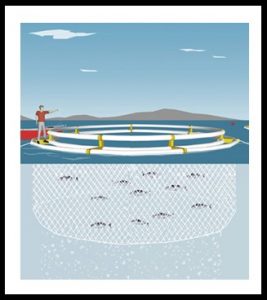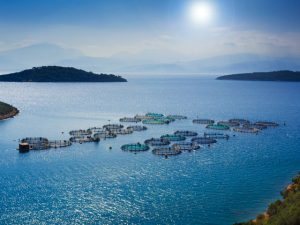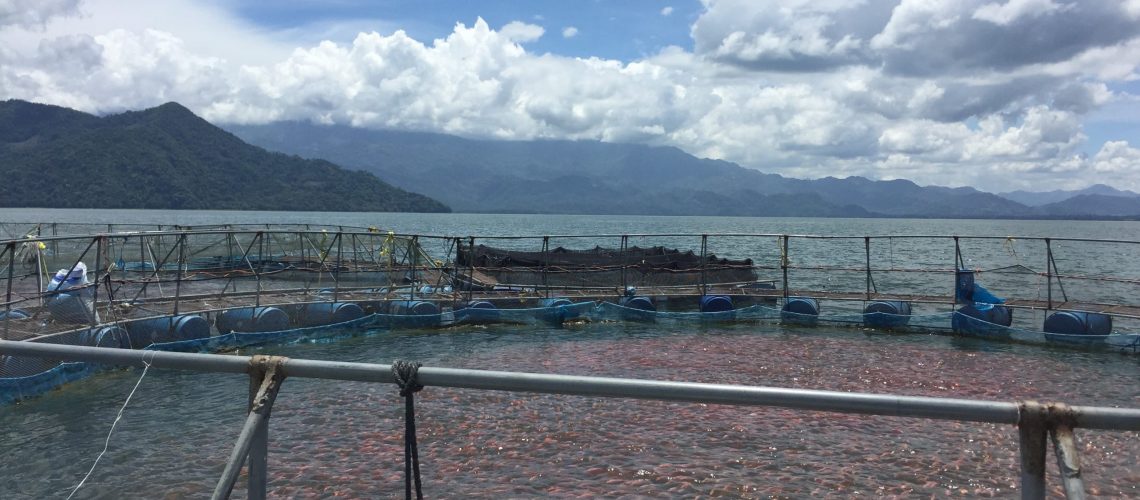Guest Post By Jemma Fadum, 2019-2020 Sustainability Leadership Fellow and Ph.D. Student in the Department of Ecosystem Science and Sustainability and the Graduate Degree Program in Ecology
Understanding where our food comes from is an increasingly prevalent and important conversation among consumers. This is reflected in product certifications such as Fair Trade and Rainforest Alliance (logos you might recognize from bags of coffee in particular), in gardening programs for kids, and even in the popularity of Netflix documentaries centered around food and its sources. So let’s take a minute to talk about fish and more specifically, aquaculture.
Aquaculture, the practice of raising seafood (fish, mussels, shrimp etc.) in ponds, raceways or floating pens (as opposed to harvesting seafood from a natural habitat) is a global industry which provides approximately 76% of the freshwater fish (i.e. trout, tilapia, catfish etc.) that we, as a global community, consume. What’s more, the aquaculture industry (along with fisheries) supports the livelihoods of an estimated 540 million people worldwide. That’s almost 7 percent of the global population.

While aquaculture is a global phenomenon, I want to talk specifically about Latin America and the Caribbean. Even though the region accounts for a relatively small proportion of global production, Latin American and Caribbean nations are an important supplier of fish and shellfish to the USA. Take fresh Tilapia fillets for example, where the top five exporters to the USA are Honduras, Colombia, Costa Rica, Mexico and Ecuador. Or Atlantic Salmon, which the US imports from Chile at twice the rate of the next leading exporter.
While Chile, Brazil, Ecuador and Mexico account for the majority of regional production, aquaculture is carried out to varying degrees in almost all Latin American countries. However, not all aquaculture operations are created equal. This means that as consumers in the USA, our purchasing power comes the responsibility to support producers that operate without detriment to local environments and communities. To make those purchasing decisions we should consider the impacts of aquaculture: the good, the bad and the algae.
First, the “good.” Aquaculture is a growing component of the economy in Latin America and the Caribbean, providing employment both directly and indirectly. This includes important employment opportunities for women, especially in post-harvest and processing activities. Aquaculture also provides a protein source for local communities. However, as with everything, there is another side. Despite the potential positive economic impacts, there are several environmental concerns associated with aquaculture. Here we will focus on just one: excessive algal growth.
With the market for captive raised seafood on the rise, aquaculture operations will need to increase their output significantly to keep pace with demand. Increasing production means increasing the environmental impact of the industry. In net-pen systems for example, fish are raised in large floating cages within a body of water, similar to the way cattle are kept inside a fence within a larger landscape. However, unlike cattle farming the waste materials produced by the animals (e.g., uneaten feed and fish poop) are not confined to the cage and instead mix with the surrounding water. This can kickstart a process called “eutrophication”. If you have ever had a fish tank that started growing too much algae, you have witnessed eutrophication on a micro-scale. However, unlike your fish tank where you can change the water and scrub out the algae, correcting the damage done to lakes and reservoirs can be difficult, expensive, and slow – if not impossible.

So what can you do? While efforts to understand what truly constitutes sustainable standards for aquaculture are still underway, choosing a sustainably certified product can go a long way in supporting companies dedicated to protecting the environment and the communities in which they operate. Accreditations such as those of the Aquaculture Stewardship Council, Ocean Wise, Global Aquaculture Alliance and Best Aquaculture Practices can help identify products that meet the leading industry standards of sustainability. To make things easier, the Monterey Bay Aquarium Seafood Watch provides consumer guides on ethical and sustainable choices. They have a mobile app and pocket guide to help you decide not just which kinds of seafood are most sustainable, but which countries offer the most sustainably produced product. Understanding where our fish comes from and making changes to our buying habits is a small change we can all make to help protect communities and natural resources around the world.
Information Sources:
The Food and Agriculture Organization (FAO) of the United Nations provided the majority of information included above with additional information from the United Stated Department of Agriculture (USDA) Economic Research Service.






